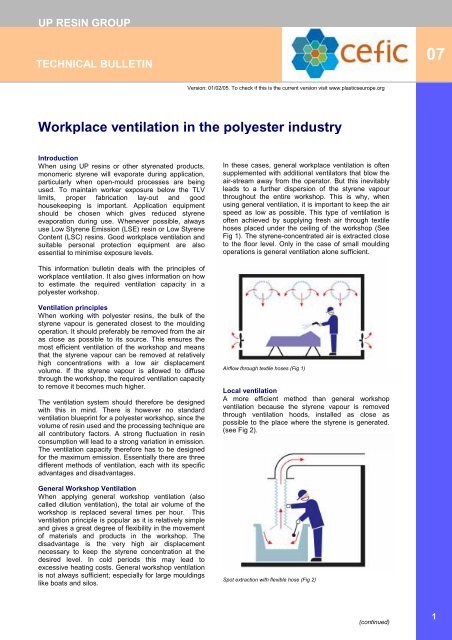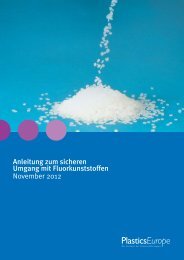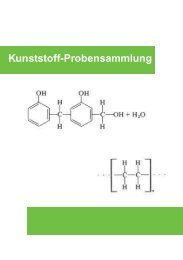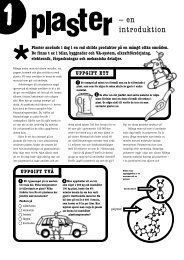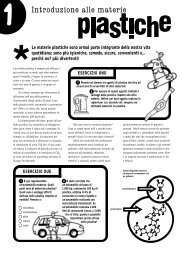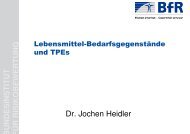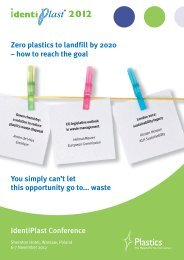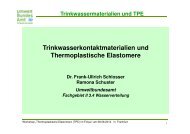Workplace ventilation in the polyester industry - PlasticsEurope
Workplace ventilation in the polyester industry - PlasticsEurope
Workplace ventilation in the polyester industry - PlasticsEurope
Create successful ePaper yourself
Turn your PDF publications into a flip-book with our unique Google optimized e-Paper software.
UP RESIN GROUP<br />
TECHNICAL BULLETIN<br />
<strong>Workplace</strong> <strong>ventilation</strong> <strong>in</strong> <strong>the</strong> <strong>polyester</strong> <strong>in</strong>dustry<br />
Introduction<br />
When us<strong>in</strong>g UP res<strong>in</strong>s or o<strong>the</strong>r styrenated products,<br />
monomeric styrene will evaporate dur<strong>in</strong>g application,<br />
particularly when open-mould processes are be<strong>in</strong>g<br />
used. To ma<strong>in</strong>ta<strong>in</strong> worker exposure below <strong>the</strong> TLV<br />
limits, proper fabrication lay-out and good<br />
housekeep<strong>in</strong>g is important. Application equipment<br />
should be chosen which gives reduced styrene<br />
evaporation dur<strong>in</strong>g use. Whenever possible, always<br />
use Low Styrene Emission (LSE) res<strong>in</strong> or Low Styrene<br />
Content (LSC) res<strong>in</strong>s. Good workplace <strong>ventilation</strong> and<br />
suitable personal protection equipment are also<br />
essential to m<strong>in</strong>imise exposure levels.<br />
This <strong>in</strong>formation bullet<strong>in</strong> deals with <strong>the</strong> pr<strong>in</strong>ciples of<br />
workplace <strong>ventilation</strong>. It also gives <strong>in</strong>formation on how<br />
to estimate <strong>the</strong> required <strong>ventilation</strong> capacity <strong>in</strong> a<br />
<strong>polyester</strong> workshop.<br />
Ventilation pr<strong>in</strong>ciples<br />
When work<strong>in</strong>g with <strong>polyester</strong> res<strong>in</strong>s, <strong>the</strong> bulk of <strong>the</strong><br />
styrene vapour is generated closest to <strong>the</strong> mould<strong>in</strong>g<br />
operation. It should preferably be removed from <strong>the</strong> air<br />
as close as possible to its source. This ensures <strong>the</strong><br />
most efficient <strong>ventilation</strong> of <strong>the</strong> workshop and means<br />
that <strong>the</strong> styrene vapour can be removed at relatively<br />
high concentrations with a low air displacement<br />
volume. If <strong>the</strong> styrene vapour is allowed to diffuse<br />
through <strong>the</strong> workshop, <strong>the</strong> required <strong>ventilation</strong> capacity<br />
to remove it becomes much higher.<br />
The <strong>ventilation</strong> system should <strong>the</strong>refore be designed<br />
with this <strong>in</strong> m<strong>in</strong>d. There is however no standard<br />
<strong>ventilation</strong> bluepr<strong>in</strong>t for a <strong>polyester</strong> workshop, s<strong>in</strong>ce <strong>the</strong><br />
volume of res<strong>in</strong> used and <strong>the</strong> process<strong>in</strong>g technique are<br />
all contributory factors. A strong fluctuation <strong>in</strong> res<strong>in</strong><br />
consumption will lead to a strong variation <strong>in</strong> emission.<br />
The <strong>ventilation</strong> capacity <strong>the</strong>refore has to be designed<br />
for <strong>the</strong> maximum emission. Essentially <strong>the</strong>re are three<br />
different methods of <strong>ventilation</strong>, each with its specific<br />
advantages and disadvantages.<br />
General Workshop Ventilation<br />
When apply<strong>in</strong>g general workshop <strong>ventilation</strong> (also<br />
called dilution <strong>ventilation</strong>), <strong>the</strong> total air volume of <strong>the</strong><br />
workshop is replaced several times per hour. This<br />
<strong>ventilation</strong> pr<strong>in</strong>ciple is popular as it is relatively simple<br />
and gives a great degree of flexibility <strong>in</strong> <strong>the</strong> movement<br />
of materials and products <strong>in</strong> <strong>the</strong> workshop. The<br />
disadvantage is <strong>the</strong> very high air displacement<br />
necessary to keep <strong>the</strong> styrene concentration at <strong>the</strong><br />
desired level. In cold periods this may lead to<br />
excessive heat<strong>in</strong>g costs. General workshop <strong>ventilation</strong><br />
is not always sufficient; especially for large mould<strong>in</strong>gs<br />
like boats and silos.<br />
Version: 01/02/05. To check if this is <strong>the</strong> current version visit www.plasticseurope.org<br />
In <strong>the</strong>se cases, general workplace <strong>ventilation</strong> is often<br />
supplemented with additional ventilators that blow <strong>the</strong><br />
air-stream away from <strong>the</strong> operator. But this <strong>in</strong>evitably<br />
leads to a fur<strong>the</strong>r dispersion of <strong>the</strong> styrene vapour<br />
throughout <strong>the</strong> entire workshop. This is why, when<br />
us<strong>in</strong>g general <strong>ventilation</strong>, it is important to keep <strong>the</strong> air<br />
speed as low as possible. This type of <strong>ventilation</strong> is<br />
often achieved by supply<strong>in</strong>g fresh air through textile<br />
hoses placed under <strong>the</strong> ceil<strong>in</strong>g of <strong>the</strong> workshop (See<br />
Fig 1). The styrene-concentrated air is extracted close<br />
to <strong>the</strong> floor level. Only <strong>in</strong> <strong>the</strong> case of small mould<strong>in</strong>g<br />
operations is general <strong>ventilation</strong> alone sufficient.<br />
Airflow through textile hoses (Fig 1)<br />
Local <strong>ventilation</strong><br />
Lo A more efficient method than general workshop<br />
<strong>ventilation</strong> because <strong>the</strong> styrene vapour is removed<br />
through <strong>ventilation</strong> hoods, <strong>in</strong>stalled as close as<br />
possible to <strong>the</strong> place where <strong>the</strong> styrene is generated.<br />
(see Fig 2).<br />
Spot extraction with flexible hose (Fig 2)<br />
(Cont<strong>in</strong>ued)<br />
(cont<strong>in</strong>ued)<br />
07<br />
1
TECHNICAL BULLETIN (cont<strong>in</strong>ued)<br />
Sit<strong>in</strong>g <strong>the</strong> <strong>ventilation</strong> hoods can be made flexible, so<br />
<strong>the</strong>y ma<strong>in</strong>ta<strong>in</strong> <strong>the</strong>ir efficiency, even when different<br />
products are produced. To stay effective, <strong>ventilation</strong><br />
hoods must be placed as close as possible to <strong>the</strong> work<br />
area. Ventilation hoods can hamper <strong>the</strong> freedom of<br />
movement around <strong>the</strong> mould, which is a significant<br />
disadvantage.<br />
When <strong>ventilation</strong> hoods are comb<strong>in</strong>ed with an array of<br />
airstreams that push <strong>the</strong> styrene-laden air directly to<br />
<strong>the</strong> <strong>ventilation</strong> hood, a so-called push-pull system<br />
results, which can reduce <strong>the</strong> styrene exposure very<br />
effectively. For small parts lam<strong>in</strong>at<strong>in</strong>g tables can be<br />
equipped with down draft open pattern tops <strong>in</strong><br />
comb<strong>in</strong>ation with semi-enclosed exhaust hoods (see<br />
Fig 3). A good example of local <strong>ventilation</strong> is <strong>the</strong> use of<br />
suction channels <strong>in</strong> <strong>the</strong> floor of <strong>the</strong> workplace,<br />
comb<strong>in</strong>ed with a supply of fresh air from above <strong>the</strong><br />
mould. In this way <strong>the</strong> operator is always work<strong>in</strong>g with<br />
his breath<strong>in</strong>g zone <strong>in</strong> fresh air (see Fig 4). Local<br />
<strong>ventilation</strong> is most effective when relatively small<br />
products are made <strong>in</strong> a fixed place.<br />
Zonal <strong>ventilation</strong><br />
Zonal <strong>ventilation</strong> comb<strong>in</strong>es general <strong>ventilation</strong> with<br />
local <strong>ventilation</strong>. In this case part of <strong>the</strong> total workshop<br />
or compartment is ventilated <strong>in</strong> such a way that <strong>the</strong><br />
styrene is removed before it is diluted <strong>in</strong>to <strong>the</strong> air of <strong>the</strong><br />
total workshop. Divid<strong>in</strong>g a workshop <strong>in</strong>to<br />
compartments is only effective when <strong>the</strong>re is a good<br />
balance between <strong>the</strong> supply of fresh air to <strong>the</strong><br />
compartment and <strong>the</strong> removal of <strong>the</strong> contam<strong>in</strong>ated air.<br />
Spray booths are a good example of <strong>the</strong> use of zonal<br />
<strong>ventilation</strong>. A spray booth is a compartment, more or<br />
less separated from <strong>the</strong> rest of <strong>the</strong> workshop. The air<br />
stream can be better controlled and less air is<br />
necessary to remove <strong>the</strong> styrene vapour.<br />
The airspeed <strong>in</strong> <strong>the</strong> entrance of a spray-booth should<br />
be designed between 0,3 and 1,0 m/s., which may still<br />
result <strong>in</strong> a major air displacement. There are various<br />
ways to optimize air displacement <strong>in</strong> a spray booth. Fig<br />
6 series shows how <strong>the</strong> air flow <strong>in</strong> a spray booth can<br />
be optimised. The first sketch (6a) shows that an open<br />
spray exhaust may lead to a lot of turbulence. But if<br />
<strong>the</strong> spray booth is carefully designed to direct airflow to<br />
<strong>the</strong> back of <strong>the</strong> booth (see Fig 6 series b-d), <strong>the</strong>n less<br />
turbulence is caused and hence less air is required for<br />
<strong>the</strong> extraction of styrene.<br />
Estimat<strong>in</strong>g <strong>ventilation</strong> requirements<br />
The rate of styrene evaporation <strong>in</strong> a <strong>polyester</strong><br />
workshop depends on many variables, such as <strong>the</strong><br />
type of res<strong>in</strong>, application process, application<br />
equipment used, tool design and configuration etc. As<br />
a guide, figure 7 <strong>in</strong>dicates <strong>the</strong> typical percentage of<br />
styrene loss <strong>in</strong> different process<strong>in</strong>g techniques,<br />
calculated as a loss <strong>in</strong> <strong>the</strong> weight of res<strong>in</strong>.<br />
Out-mould <strong>in</strong>duction ‘push-pull’ (Fig 3)<br />
Portable table (Fig 4)<br />
Booth optimisation set-ups<br />
Open exhaust (5m ceil<strong>in</strong>g) (Fig 6a)<br />
Booth (5m x 2.5m open<strong>in</strong>g) (Fig 6b)<br />
(cont<strong>in</strong>ued)<br />
07<br />
2
TECHNICAL BULLETIN 03 (cont<strong>in</strong>ued)<br />
Process<br />
Styrene loss<br />
(% of res<strong>in</strong> weight)<br />
Gelcoat Spray 10-14 %<br />
Spray-up, non-LSE res<strong>in</strong> 7-10 %<br />
Gelcoat, Hand brush 6-8 %<br />
Filament w<strong>in</strong>d<strong>in</strong>g 5-7 %<br />
Hand Lay-up, non-LSE res<strong>in</strong> 4-6 %<br />
Spray-up, LSE/LSC res<strong>in</strong> 4-6 %<br />
Topcoat, spray 4-5 %<br />
Topcoat, Hand brush 3-4 %<br />
Hand Lay-up, LSE/LSC res<strong>in</strong> 3-4 %<br />
Pultrusion 1-3 %<br />
Cont<strong>in</strong>uous lam<strong>in</strong>ation 1-2 %<br />
SMC/BMC Manufactur<strong>in</strong>g 1-2 %<br />
SMC/BMC process<strong>in</strong>g 1-2 %<br />
Closed Processes (RTM/RTM<br />
Light/Infusion)<br />
Fig 7, Styrene loss by process<br />


